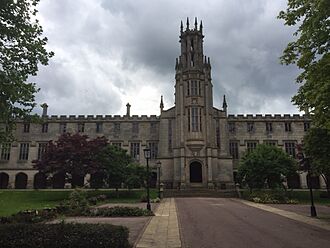British Muslim Heritage Centre facts for kids
Quick facts for kids British Muslim Heritage Centre |
|
|---|---|

British Muslim Heritage Centre
|
|
| Former names | GMB National College |
| General information | |
| Architectural style | Gothic Revival |
| Address | College Road, Whalley Range, Manchester, M16 8BP |
| Design and construction | |
| Architect | Irwin and Chester |
| Designations | |
|
Listed Building – Grade II*
|
|
| Official name: GMB National College | |
| Designated: | 2 October 1974 |
| Reference #: | 1197762 |
The British Muslim Heritage Centre is a special building in Whalley Range, Manchester, England. It used to be called the GMB National College. This building is very old, built between 1840 and 1843. It has a beautiful Gothic Revival style, which looks like old castles or churches. It was officially recognized as an important historical building on October 3, 1974.
Contents
History and Purpose
A College for Learning
The building was first built as a college for students who couldn't go to the famous Oxford and Cambridge universities. These students were often from different religious groups. The college was called the Lancashire Independent College. It was started by three important people: George Hadfield, Thomas Raffles, and William Roby.
The college was built on land that was quite wet and marshy. Workers had to dig out a lot of peat, which is a type of soil, before they could build safely. The building's design looks a lot like the colleges at Oxford or Cambridge. This was probably done on purpose.
Architectural Style
A famous expert named Nikolaus Pevsner admired the building's long and impressive front. He noted its tall, unique tower and a special two-story window. Inside, some parts were changed later by an architect named Alfred Waterhouse. The rooms on the main floor are very charming, with lovely fireplaces and ceilings.
Changes Over Time
During World War II, which was a big global conflict, the college was used to help people. It gave shelter to teachers and scholars who had to leave their homes, especially from a country called Czecho-Slovakia.
Later, the college became known as the Northern Congregational College. It continued to be used for education until 1985. After that, the building was bought by the GMB, which is a large group that helps workers. They used it to train people who negotiate for workers' rights.
In 2004, the GMB decided to sell the building because it was too expensive to keep. After some time, the British Muslim Heritage Centre bought it. Their goal was to create a place that celebrates Muslim history and identity in Britain.
Recent Recognition
The British Muslim Heritage Centre has been recognized for its work. In 2013 and 2014, it was nominated for an award for Arts and Culture Awareness. A trustee of the centre, Nasar Mahmood, received a special award called an OBE in 2019 for his contributions.
See also
- Grade II* listed buildings in Greater Manchester
- Listed buildings in Manchester-M16

